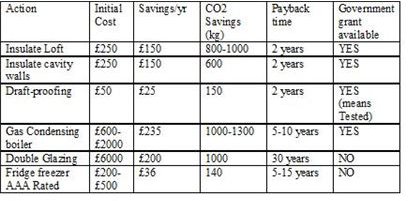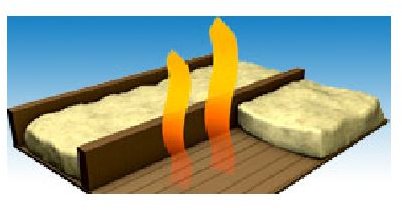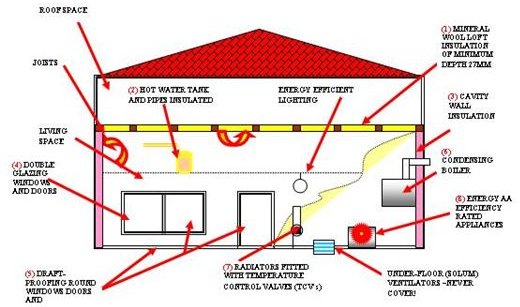Ways to Reduce Energy Consumption to Reduce Carbon Footprint and Save Money
Reduced Carbon Footprint = Money in Your Pocket
I was an engineer for 20 years in the offshore oil and gas industry when I had to retire early due to ill health. I wanted to do something different and keep myself busy so I enrolled with the Open University, and after five years achieved my BSC with honors in Environmental Studies.
The following article on home insulation and energy savings details some of the changes I have made to my lifestyle due to my studies on the environment.
Remember a__ny savings we make in CO2 emissions will help toward the reduction in Global warming. These savings, no matter how small – all add up; changing how you look at CO2 emissions will possibly be the most important steps you have ever taken, in saving our world as we know it today.
We begin the article by examining the household areas that require insulation to be applied to stop them loosing heat energy and move onto components that can be upgraded to more energy efficient models.
I hope you find this article informative / interesting and that may you too choose to pursue some of these ideas yourselves, reducing your carbon footprint.
Places in the Home that Must Be Insulated
1. Loft Insulation
An un-insulated loft will allow a quarter of the heat in your house to disappear into the loft space and out through the roof tiles.
To combat this we use loft insulation, which comes in rolls at convenient widths to fit between the loft floor joists. The insulation is covered by a government grant and can be fitted by the average DIY person.
However, the insulation contains small prickly fibers that will stick to your clothes, also irritating the skin and eyes, so a disposable paper suit, goggles and a face mask should be worn when installing the insulation.
The thicker the insulation the better; in the UK recent Building Regulations specify using 270mm (11”) thick mineral wool insulation, and can save up to a ton of CO2 emissions per year.
Most States in the US and Europe have also adopted 270mm as the optimum thickness of mineral wool to be used as loft insulation.
2. Lagging Hot Water Tank and Pipes
A good water tank jacket should be of at least 3” thick. Ours has a built on foam insulation, but this misses out on openings for thermostats and pipes intersections so I have used old towels around these areas. Hot water pipes need to be lagged. This tubular lagging cost a few pennies in DIY shops and can be fitted in minutes with no tools.
3. Cavity Wall Insulation
If your house is built with double brick walls, then there will have been a space left between the two ‘walls’ this space allows hot air to escape, but if the cavity is filled with an insulating foam, this stops the heat loss. Government grants are also available this giving savings heating bills as well as CO2 emissions.
4. Double Glazing
Single glazing in steel frames is the most inefficient glazing for our homes. There is a grant available for upgrading to double glazed units.
Double glazing is expensive and can take up to 20 years to pay for its installation, but most modern houses are now built to the latest standards and that includes double or triple glazed windows.
The most modern double glazing is the glazing which has the ‘air gap’ filled with an inert gas such as argon or nitrogen. This prevents the transfer of heat between the inside of the house and the outside atmosphere most efficiently, manufacturers claiming the prevent 1/3 of heat from escaping.
5. Draft Exclusion
This is very important as cold air reduces your home inside temperature requiring more heat, at a financial cost and CO2 emission.
Draft exclusion is very simply carried out by putting foam strips around windows and doors, my Dad used to put a few layers of old newspapers between the carpets and floorboards to prevent drafts from the solum ventilation, but nowadays a good quality thick carpet and underlay provide adequate draft exclusion.
Reference Webs:
- energysavingtrust - loft insulation
- energysavingtrust - home insulation
Household Energy Efficient Appliances
1. Central Heating Boiler
In the past I have owned houses having electric central heating which I changed these to an open-fire back-boiler central heating system. Nowadays most of our homes are supplied with Natural Gas enabling us to install a modern energy efficient gas condensing boiler. These can be up to 88% efficient and are well worth considering when upgrading your old boiler, especially as they are much cheaper to run and, there are government grants available to offset part of the cost.
2. Radiator Thermostatic Control Valves
These are a must for cheap, adjustable and efficient control of room temperatures. They are fitted to the radiators, usually the hot water inlet and allow individual control of room temperature by opening and closing automatically, and once set rarely need to be adjusted.
3. Energy Efficient Kitchen Appliances
When the time comes to replace our washing machines, dishwashers, fridge freezers, tumble dryers and stoves, we can save energy costs and CO2 emissions by purchasing AA rated appliances. This is a government rating and ensures we are using the most modern, efficient and energy saving equipment.
Reference Webs:
- energysaving trust - condensing boilers
- energysavingtrust - energy efficient kitchen appliances
Summary
Many of the world’s leading scientists have confirmed that global warming is due to the collection of greenhouse gasses in our atmosphere; the prime culprit being carbon dioxide (CO2).
The CO2 emissions are mainly from our increasing dependency on fossil fuels for energy production, and the majority of this energy is used in our homes.
There are several methods that can be used to reduce our personal CO2 emissions; insulating the home to prevent heat loss, and choosing energy efficient home appliances when replacing older ones.
Most insulation in the home can be carried out by the average DIY person, with the exception of cavity wall insulation and double glazing; government grants may be available to help with the costs.
Energy efficient domestic appliances such as washing machines and fridge/freezers all carry energy efficiency ratings, so these should be checked and the most efficient model chosen. These modern appliances use much less energy than the older models.
Household Heat Losses, Table of Home Energy Savings and Loft Insulation Heat Loss


This post is part of the series: Energy Savings Tips for the Home
In this series, you will find some energy savings tips for the home that will also end up saving you money in the long run. You will learn about better insulation for your home’s roof and walls, draft-proof windows and doors, hot water tanks, and more efficient central heating systems.
- Energy Efficient Fixes for Your House Reduces Carbon Footprint
- High Efficiency Central Heating System Components - Condensing Boilers and Programmable Timers
- Improve Your Home Heating Using Energy Efficient Heating System Components
- Recycling and Reuse of Old Hot Air Central Heating Systems
- Save Energy for Your Home - Take the Survey
